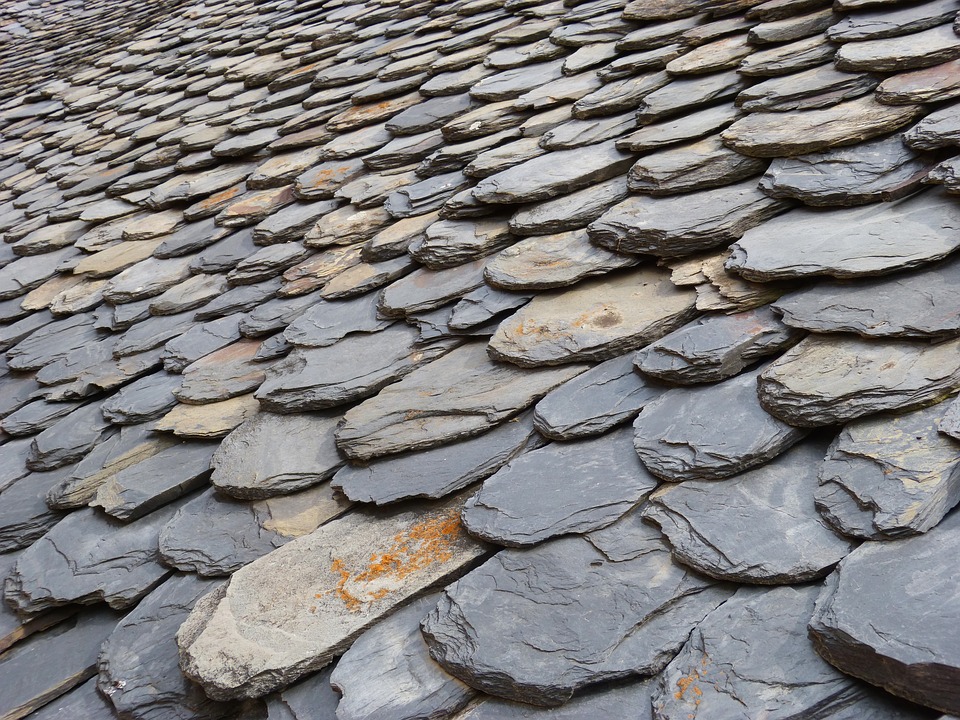If you are considering purchasing a slate roof, you may be asking yourself, ‘how long does a slate roof last?’ Knowing the roof’s lifespan helps you prepare for replacement and check for roof repairs. As a result, you’ll make informed decisions whether to invest in it or not.
Most homeowners prefer slate roofs because they increase curb appeal and are durable. Even though these roofs are more expensive, they are a top choice for many. Could it be because they are long-lasting? And how long do they last?
Before we find out the longevity of slate roofs, let us first look at what the roof is made of. It is also essential to know the pros and cons of each roofing material before purchasing.
Let’s get started.
What Is A Slate Roof?
A slate roof is made from a naturally occurring stone called metamorphic rock. The rock contains other minerals like mica, quartz, and chlorite, and you can easily split it into many thin slabs.
Most slate roofs are gray due to the stone’s natural color, but other roofs are red or green. The color mainly depends on the amount of minerals present in the rock.
Slate roofs increase the home’s aesthetics and value. Not only do these roofs last long, but they also require little maintenance.
How long does a slate roof last?
While researching different roofing materials, it is essential to look at their longevity. However, although a roof’s lifespan could be after 20 or 30 years, exposure to other elements shortens the longevity.
Slate roofs are durable and can withstand harsh climatic conditions for over 75 years. They are weather resistant because they are made of naturally occurring material.
However, since the roofs are made from rock, manufacturers do not issue warranties. Therefore, homeowners should hire experienced roofers to ensure they don’t suffer poor roof installation problems.
Factors Affecting Slate Roof’s Longevity
Although most roofing materials last long, other external factors affect their longevity. Some factors to consider when buying a slate roof are:
- Installation
No matter how strong a roofing material is, poor installation will shorten its longevity. The top materials will only last long if correctly installed. Moreover, poor installation leads to other roofing problems like leaks, curling, and rotting.
For example, missing or misplaced shingles due to poor roof installation will allow water to seep through the roof into the inner materials. These materials are not water-resistant, and as a result, they will start rotting and weakening.
Roofs with wood rafters and beams soak the water and begin to swell. With time, the swelling leads to rotting and can affect other parts. The poor installation also exposes other inner parts of the roof like underlayment and insulation, speeding up their aging.
- Weather Elements And Climatic Conditions
It is important to understand how different weather conditions affect the roofing material. Although slate is a naturally occurring material and is resistant to most climatic conditions, some elements are extreme and can expedite its deterioration.
Large hail and storms can cause tree branches to fall on the roof leading to breakage.
Poor flashing, missing shingles, and the wrong choice of the roof for your home’s roof structure can lead to other roofing problems. For example, the incorrect installation of slate shingles on a flat roof causes depressions that collect water.
Exposure of the inner roof materials to direct sunlight causes faster wear and tear of the internal parts, weakening the shingles. However, although you cannot do much about the weather, hire experienced installers like the professionals at Roof Master and Construction.
- Maintenance
Once your slate roof is installed, regular maintenance will ensure it remains in good shape. Roof maintenance is essential for even the most long-lasting materials. Clean the gutters by removing leaves and any other materials blocking them.
The gutters are the roof’s primary drainage system, and leaving them dirty can lead to moisture damage. This happens when water collects on the roof after it rains due to poor drainage.
Ensure you also examine the roof’s flashing and the metal framing. Improper flashing will lead to leaks causing damage to the inner roof parts.
During a roof inspection, avoid stepping on the shingles directly. Slate shingles are delicate and can easily break when stepped on. Also, wear protective garments like shoes with enough grip and a helmet before climbing up the roof.
Advantages Of Slate Roofs
Here are some of the reasons why homeowners prefer slate roofs:
- Longevity And Durability
Roofs are expensive to buy and install, and every homeowner wants to get value for their money. Most homeowners purchase slate roofs because of their longevity. Once you buy this roof and hire a good installer, it is likely that the roof will last 75 years without requiring a replacement.
- Increased Curb Appeal
Slate roofs are stylish and classy and are available in various colors to match your walls, windows, or doors. You can also get them in multiple sizes, textures, and patterns.
- Eco-Friendly
Since slate roofs are made from naturally occurring rocks, they are not harmful to the environment. This factor beats the fiberglass, vinyl, and aluminum roofs that cause pollution when disposed of.
Final Words
Slate roofs are a more expensive option, but many people become attracted to their longevity after asking the question: ‘How long will a slate roof last?’ Although these roofs will last many decades, note that other factors can reduce longevity. Luckily, now you know how to care for your roof and the importance of hiring a good installer. Contact us for more information on slate roofs or to connect with a professional installer.



